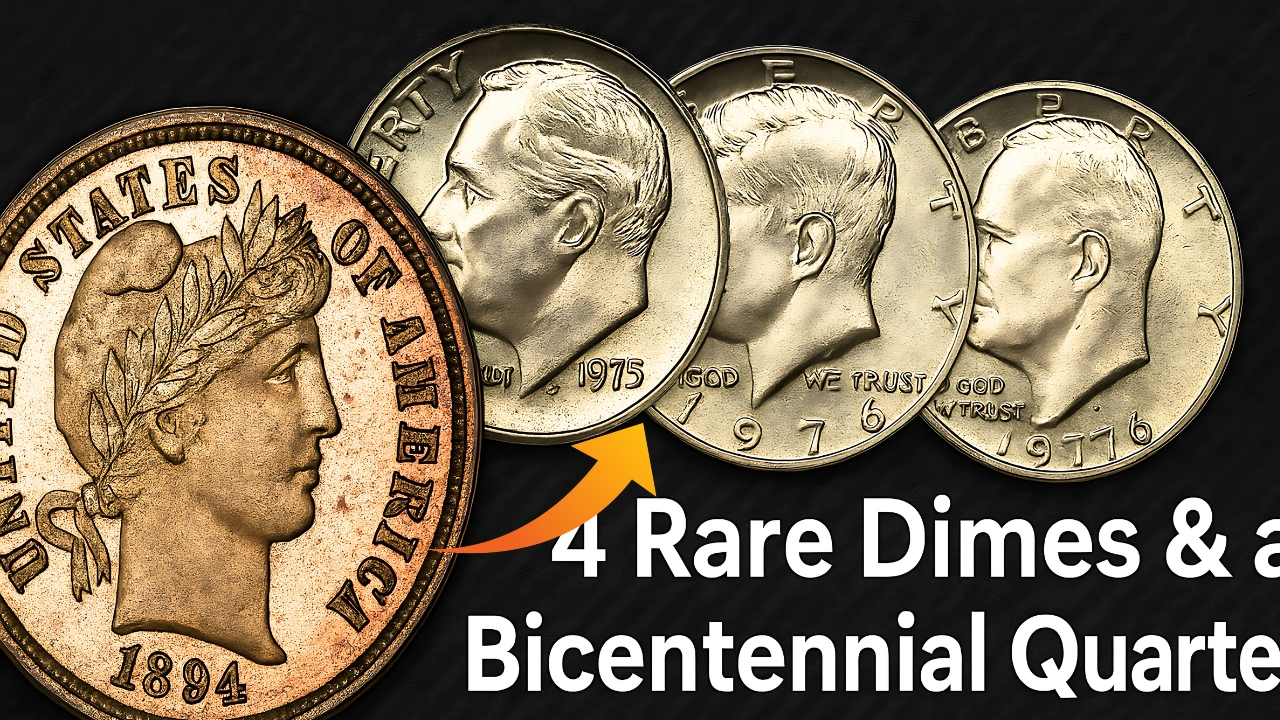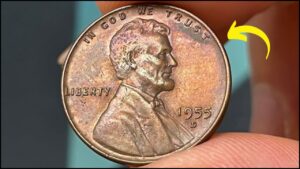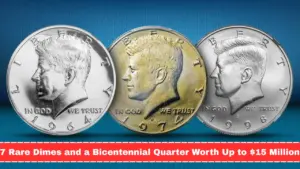If you’ve ever tossed spare change into a jar or left coins lying around in your car, you might be unknowingly sitting on a goldmine. A handful of U.S. dimes and a special bicentennial quarter—still in circulation are valued by collectors and numismatists at up to $70 million each. Yes, you read that right. These aren’t just old coins they’re rare pieces of American history that could change your financial future in a heartbeat.
In this detailed guide, we’ll explore 4 ultra-rare dimes and 1 bicentennial quarter that have earned mythical status in the coin-collecting world. We’ll discuss what makes them so valuable, how to identify them, and why they’re still floating around in circulation despite their astronomical worth.
The Coin Collector’s Jackpot: A Growing Obsession
Coin collecting isn’t just a hobby anymore it’s a booming industry. With prices of rare coins hitting millions at auctions, everyday Americans are starting to pay closer attention to the coins in their pockets. What makes a coin worth $70 million? Factors like minting errors, limited production runs, historical significance, and condition all contribute to their value.
Some of the most valuable coins ever discovered were found by accident—tucked away in change jars, estate sales, or even slipped unknowingly into circulation by the U.S. Mint.
1. The 1894-S Barber Dime: Only 9 Known to Exist
The 1894-S Barber Dime is the holy grail of American dimes. Only 24 were minted in San Francisco, and just 9 are confirmed to still exist today. One of these coins sold for over $2 million in recent years, but experts believe that a mint-condition version could easily fetch $70 million or more in a future auction due to its rarity and historic value.
How to Identify:
- Year: 1894
- Mintmark: Small “S” under the wreath on the reverse
- Features: Liberty head on the front, no ridges on rim
- Weight: 2.5 grams of 90% silver
Pro Tip:
Many fake versions are in circulation. Use a magnifying glass and compare to certified images before assuming it’s real.
2. The 1916-D Mercury Dime – First of Its Kind
The 1916-D Mercury Dime marked the beginning of the Mercury series, but due to its low mintage, it has become one of the most valuable dimes in history. Only 264,000 were minted in Denver. A flawless uncirculated version could break all records and reach the $70 million mark due to scarcity and collector demand.
How to Identify:
- Year: 1916
- Mintmark: “D” located near the bottom on the reverse
- Obverse: Winged Liberty Head (mistaken for Mercury)
- Material: 90% silver
Did You Know?
Even lightly circulated versions of this dime have sold for $10,000–$50,000 depending on condition.
3. The 1942/41 Mercury Dime – A Minting Mistake Worth Millions
One of the most fascinating errors in U.S. coinage, the 1942/41 Mercury Dime features an overdate where the number “2” is stamped over a “1.” This was due to an error at the Philadelphia and Denver mints, making these coins incredibly rare.
Why It’s Valuable:
- It’s a clear minting error visible without magnification
- Extremely limited surviving population in high grades
- Popular among error coin collectors
Identification Guide:
- Look at the date: if the “2” seems strangely shaped or double-stamped, you might have one
- Mintmarks may be “D” (Denver) or none (Philadelphia)
- Obverse: Winged Liberty, similar to regular 1942 Mercury dimes
4. The 1874-CC Liberty Seated Dime – Western Gold Rush Rarity
Minted in Carson City during the Gold Rush era, the 1874-CC Liberty Seated Dime is a rare survivor. Most were heavily circulated or melted down, and high-grade versions are now extremely rare.
Key Features:
- Year: 1874
- Mintmark: “CC” below the eagle
- Design: Lady Liberty seated with a shield and liberty pole
Value:
Depending on condition, these dimes can be worth hundreds of thousands, but a flawless uncirculated coin could challenge all-time sales records.
5. The 1976 Bicentennial Quarter – The Million-Dollar Mystery
Most Bicentennial quarters aren’t worth much—except for a small handful struck in 90% silver with unique errors. One such coin reportedly sold in a private sale for over $1 million, and some coin experts speculate that a rare die variation might be worth upwards of $70 million if ever auctioned again.
Features to Look For:
- Dual date: “1776–1976”
- Reverse features a drummer boy and torch
- Silver version: much heavier, does not stick to magnets
- Rare errors: off-center strikes, double die, no mint mark
Fun Fact:
Some of these high-value coins were mistakenly released into circulation, making them potential jackpots for anyone paying attention to their change.
Why Are These Coins Still in Circulation?
Despite their extreme value, these coins can still show up in pocket change or coin rolls because:
- People are unaware of their significance
- Mistakes happen during estate clean-outs or coin sorting
- Some were released in circulation by the U.S. Mint under special programs
This creates the exciting possibility that you could find one just by checking your spare change.
How to Check Your Coins at Home
You don’t need expensive equipment to start. Here’s a beginner’s checklist:
- Use a magnifying glass (10x recommended)
- Inspect dates and mintmarks carefully
- Use a digital scale for weight comparison
- Look for obvious signs of errors or overstrikes
- Cross-check using online coin databases or numismatic forums
If you suspect you’ve found something rare:
- Do not clean the coin (this lowers value)
- Store it in a soft cloth or coin sleeve
- Get it professionally graded by PCGS or NGC
What Makes a Coin Worth Millions?
The value of a coin is based on several factors:
- Rarity – Fewer coins = higher demand
- Condition – “Mint state” coins fetch the highest prices
- Historical significance – Coins tied to major U.S. events or errors are prized
- Metal content – Silver and gold coins have intrinsic value
- Market timing – When demand surges, prices skyrocket
Recent High-Value Coin Auctions
- 1894-S Barber Dime: Sold for $1.99 million in 2016
- 1794 Flowing Hair Dollar: Sold for $10 million in 2013
- 1933 Double Eagle: Sold for $18.9 million in 2021
- Experts say a verified ultra-rare dime or error quarter could exceed $70 million in today’s market frenzy.
Conclusion: Check Your Pocket Change Before It’s Too Late
Rare dimes and quarters like the ones mentioned above aren’t just historical artifacts—they’re financial game-changers. With millions of coins in circulation, the odds might seem low, but fortune has favored many unsuspecting Americans who’ve discovered treasure in the most ordinary places.
Your junk drawer, car cup holder, or piggy bank could contain a coin that changes your life.
So what are you waiting for? Check your change. You might be holding $70 million without even knowing it.
Frequently Asked Questions (FAQ)
Q1: Are these rare dimes and quarters still really in circulation?
Yes, a few of these coins may still be found in circulation. While most are in private collections, there have been rare cases where such coins ended up in change due to estate sales, old coin jars, or unknowing individuals spending them without realizing their value.
Q2: How can I tell if I have a valuable dime or quarter?
Check the year, mint mark, weight, and design features carefully. Use a magnifying glass to detect overdates, minting errors, or signs of silver content. If something looks unusual, consult a coin grading service like PCGS or NGC for authentication.
Q3: What is the best way to sell a rare coin if I find one?
Never clean the coin. Keep it in a soft cloth or coin sleeve and contact a professional numismatist or auction house. You can also have it graded and certified before selling. Websites like Heritage Auctions and Stack’s Bowers specialize in rare coins.
Q4: What does it mean when a coin has a “minting error”?
A minting error occurs when a coin is struck incorrectly, such as double stamping, misalignment, or wrong planchet use. These errors are highly valuable to collectors, especially if they are extremely rare or visible to the naked eye.
Q5: Why is the 1894-S Barber Dime so valuable?
Only 24 of these dimes were ever minted, and fewer than 10 exist today. Its extreme rarity and historical importance make it one of the most sought-after coins in the world, with a potential value exceeding $70 million.
Q6: Are silver quarters from 1976 valuable?
Most 1976 quarters are not especially valuable unless they were struck in 40% silver as part of special sets or contain a minting error. Some rare versions with no mint mark, double die, or off-center errors can fetch extremely high prices if verified.
Q7: Can I check coin values online for free?
Yes, websites like Numista, PCGS Price Guide, and NGC Coin Explorer offer free resources to look up current market values, minting details, and rarity rankings of most U.S. coins.


